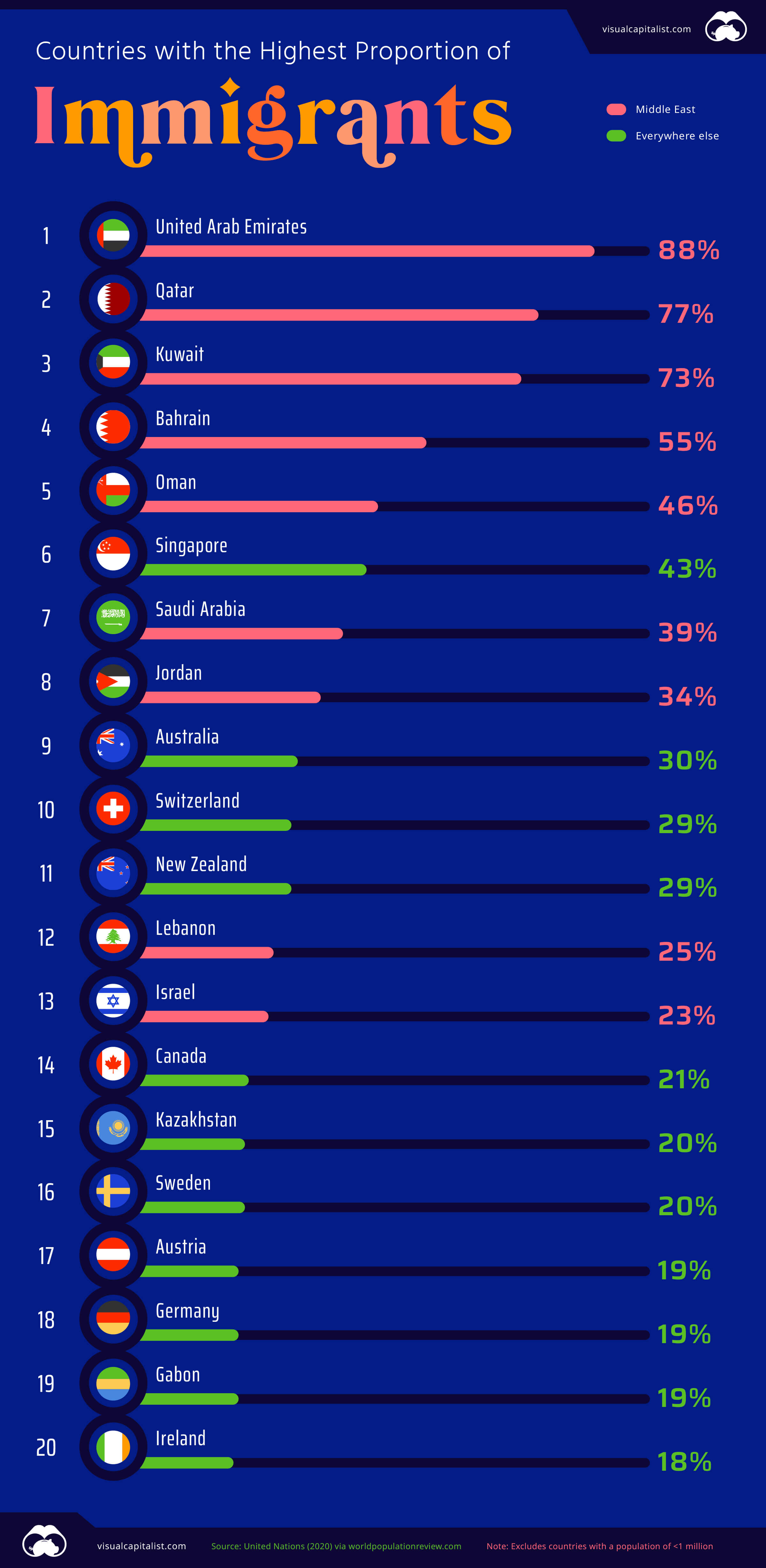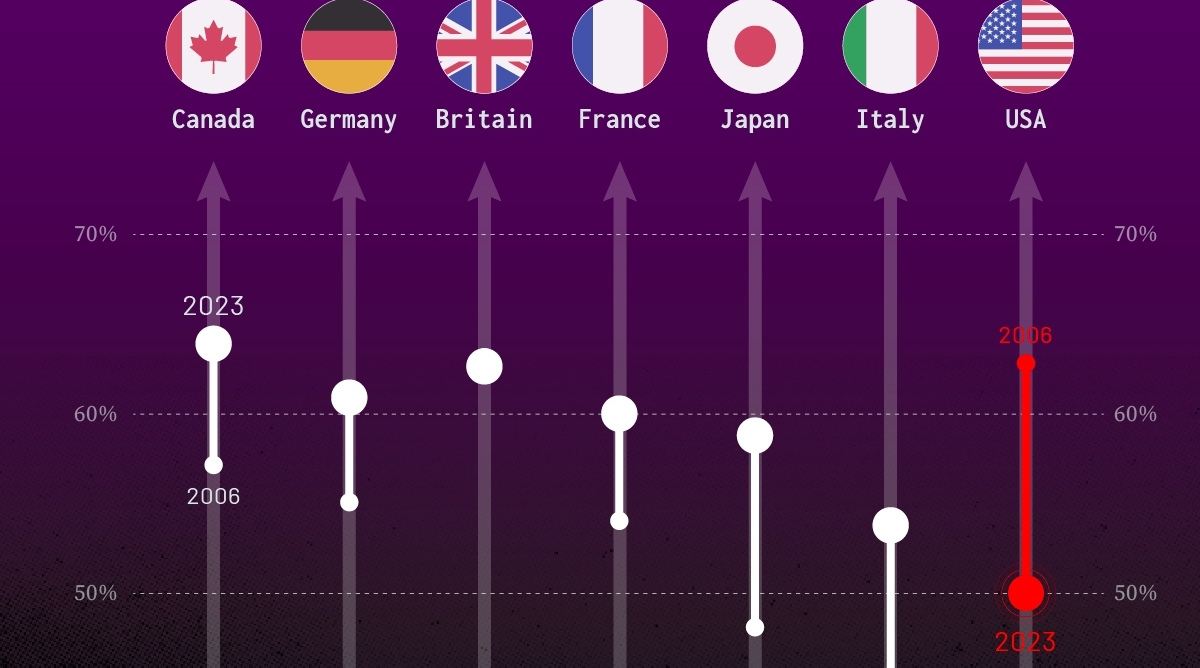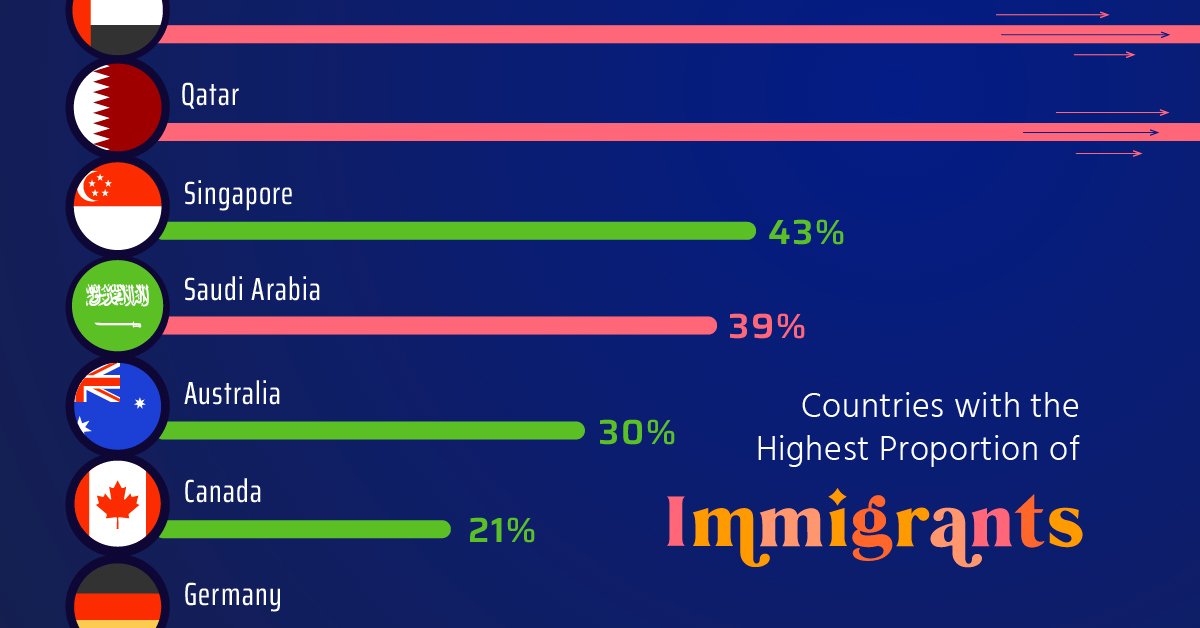Misc
Countries with the Highest (and Lowest) Proportion of Immigrants

Countries with the Highest Proportion of Immigrants
For people living in cosmopolitan urban centers, it’s easy to overestimate the prevalence of immigrants around the world.
The median proportion of foreign-born people in all countries is just over 5%. In countries with a population greater than one million, only four are majority foreign-born, and only eight surpass the one-third mark.
Here are the top 20 countries with the highest proportion of immigrants in their populations:
| Country | Immigrants as a percentage of population |
|---|---|
| 🇦🇪 United Arab Emirates | 88% |
| 🇶🇦 Qatar | 77% |
| 🇰🇼 Kuwait | 73% |
| 🇧🇭 Bahrain | 55% |
| 🇴🇲 Oman | 46% |
| 🇸🇬 Singapore | 43% |
| 🇸🇦 Saudi Arabia | 39% |
| 🇯🇴 Jordan | 34% |
| 🇦🇺 Australia | 30% |
| 🇨🇭 Switzerland | 29% |
| 🇳🇿 New Zealand | 29% |
| 🇱🇧 Lebanon | 25% |
| 🇮🇱 Israel | 23% |
| 🇨🇦 Canada | 21% |
| 🇰🇿 Kazakhstan | 20% |
| 🇸🇪 Sweden | 20% |
| 🇦🇹 Austria | 19% |
| 🇩🇪 Germany | 19% |
| 🇬🇦 Gabon | 19% |
| 🇮🇪 Ireland | 18% |
Source: UN via World Population Review. Note: Only countries with a population of greater than one million are included.
The United Arab Emirates comes out on top for the highest proportion of immigrants in its population. Impressively, the small Middle Eastern nation ranks sixth in the world for total immigrant population (8.7 million people).
Other countries on the Arabian Peninsula also rank at the top of this list. In Qatar, current host of the 2022 World Cup, 3-in-4 people are immigrants. The high proportion of foreign workers in the country also results in an extreme demographic skew—approximately 75% of the population of Qatar is male.
The one extreme outlier in the region is war-torn Yemen, where only 1.3% of the population are immigrants.
Outside the Middle East, Singapore (43%) takes top spot, followed by Australia (30%).
Spotlight on U.S. Immigration
Although the United States is outside the top 20, it still has by far the most immigrants of any other country (50 million vs. 16 million in second-place Germany).
About 15% of people in the U.S. are immigrants—numbers which are comparable to the historic high in the late 19th century. The proportion of foreign-born people in the country has been on the rise since the 1970s, and is projected to continue rising in coming decades. Around 2030, immigration is expected to surpass natural increases as a driver of population growth.
Countries with the Lowest Proportion of Immigrants
A few countries are magnets for immigration, while a great many more receive very little immigration. This can simply be due to lack of demand, or because of more extreme circumstances such as war or a failing economy. In other cases, immigration policies may limit the number of people who can migrate to a country.
Here are the top 20 countries with the lowest proportion of immigrants in their populations:
| Country | Immigrants as a percentage of population |
|---|---|
| 🇨🇺 Cuba | 0.03% |
| 🇨🇳 China | 0.07% |
| 🇻🇳 Vietnam | 0.08% |
| 🇮🇩 Indonesia | 0.13% |
| 🇲🇬 Madagascar | 0.13% |
| 🇲🇲 Myanmar | 0.14% |
| 🇭🇹 Haiti | 0.17% |
| 🇰🇵 North Korea | 0.19% |
| 🇱🇰 Sri Lanka | 0.19% |
| 🇵🇭 Philippines | 0.21% |
| 🇲🇦 Morocco | 0.28% |
| 🇮🇳 India | 0.35% |
| 🇵🇬 Papua New Guinea | 0.35% |
| 🇦🇫 Afghanistan | 0.37% |
| 🇸🇴 Somalia | 0.37% |
| 🇪🇷 Eritrea | 0.39% |
| 🇭🇳 Honduras | 0.40% |
| 🇬🇹 Guatemala | 0.47% |
| 🇰🇭 Cambodia | 0.47% |
| 🇹🇳 Tunisia | 0.51% |
Cuba has the lowest level of foreign-born people in its population. The Caribbean nation makes it very difficult for foreign nationals obtain permanent residency.
China comes in second last. In absolute terms, the million or so immigrants living in China may sound like a lot, but pales in comparison to the overall population of 1.4 billion.
Interestingly, Japan–which is the poster child for low immigration–isn’t on the list above. The country’s foreign-born population sits at just over 2%.
Politics
Charted: Trust in Government Institutions by G7 Countries
How much do you trust the government and its various institutions? We look at data for G7 countries for the time period of 2006-2023.

Trust in Government Institutions by G7 Countries
This was originally posted on our Voronoi app. Download the app for free on iOS or Android and discover incredible data-driven charts from a variety of trusted sources.
How much do you trust the government, and its various institutions?
It’s likely that your level of confidence probably depends on a wide range of factors, such as perceived competency, historical context, economic performance, accountability, social cohesion, and transparency.
And for these same reasons, trust levels in government institutions also change all the time, even in the world’s most developed countries: the G7.
Confidence in Government by G7 Countries (2006-2023)
This chart looks at the changes in trust in government institutions between the years 2006 and 2023, based on data from a multi-country Gallup poll.
Specifically, this dataset aggregates confidence in multiple national institutions, including the military, the judicial system, the national government, and the integrity of the electoral system.
| Country | Confidence (2006) | Confidence (2023) | Change (p.p.) |
|---|---|---|---|
| Canada | 57% | 64% | +7 |
| Britain | 63% | 63% | +0 |
| Germany | 55% | 61% | +6 |
| France | 54% | 60% | +6 |
| Japan | 48% | 59% | +11 |
| Italy | 41% | 54% | +13 |
| United States | 63% | 50% | -13 |
What’s interesting here is that in the G7, a group of the world’s most developed economies, there is only one country bucking the general trend: the United States.
Across most G7 countries, confidence in institutions has either improved or stayed the same between 2006 and 2023. The largest percentage point (p.p.) increases occur in Italy and Japan, which saw +13 p.p. and +11 p.p. increases in trust over the time period.
In the U.S., however, confidence in government institutions has fallen by 13 p.p. over the years. What happened?
Key Figures on U.S. Trust in Institutions
In 2006, the U.S. was tied with the UK as having the highest confidence in government institutions, at 63%.
But here’s where the scores stand in 2023, across various institutions:
| 🇺🇸 Institutions | Confidence (2023) |
|---|---|
| Military | 81% |
| Judiciary | 42% |
| National Government | 30% |
| Elections | 44% |
| Overall | 49% |
Based on this data, it’s clear that the U.S. lags behind in three key indicators: confidence in the national government, confidence in the justice system, and confidence in fair elections. It ranked in last place for each indicator in the G7.
One other data point that stands out: despite leading the world in military spending, the U.S. is only the third most confident in its military in the G7. It lags behind France (86%) and the United Kingdom (83%).
-

 Wealth6 days ago
Wealth6 days agoCharted: Which City Has the Most Billionaires in 2024?
-

 Mining2 weeks ago
Mining2 weeks agoGold vs. S&P 500: Which Has Grown More Over Five Years?
-

 Uranium2 weeks ago
Uranium2 weeks agoThe World’s Biggest Nuclear Energy Producers
-

 Education2 weeks ago
Education2 weeks agoHow Hard Is It to Get Into an Ivy League School?
-

 Debt2 weeks ago
Debt2 weeks agoHow Debt-to-GDP Ratios Have Changed Since 2000
-

 Sports2 weeks ago
Sports2 weeks agoThe Highest Earning Athletes in Seven Professional Sports
-

 Science2 weeks ago
Science2 weeks agoVisualizing the Average Lifespans of Mammals
-

 Brands1 week ago
Brands1 week agoHow Tech Logos Have Evolved Over Time















